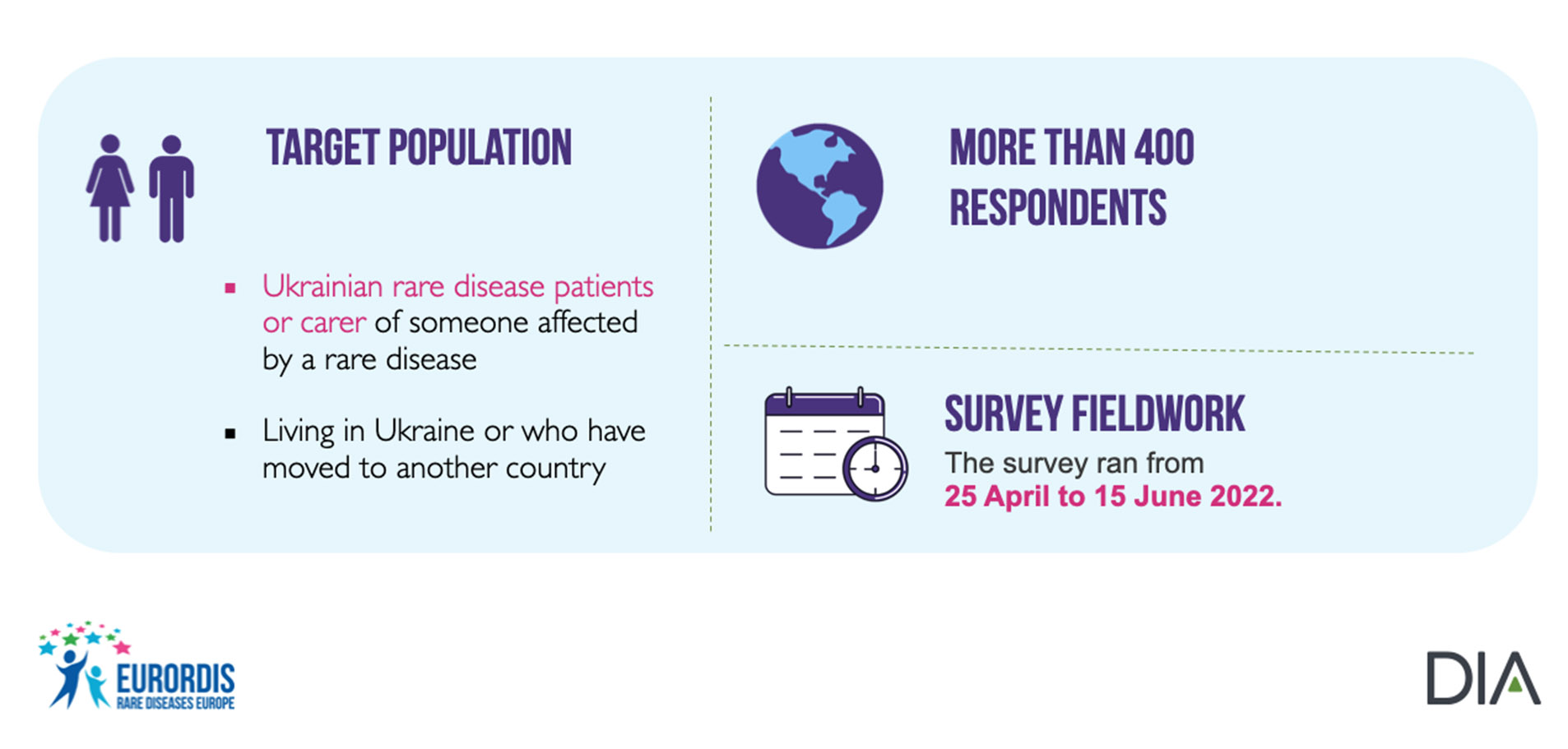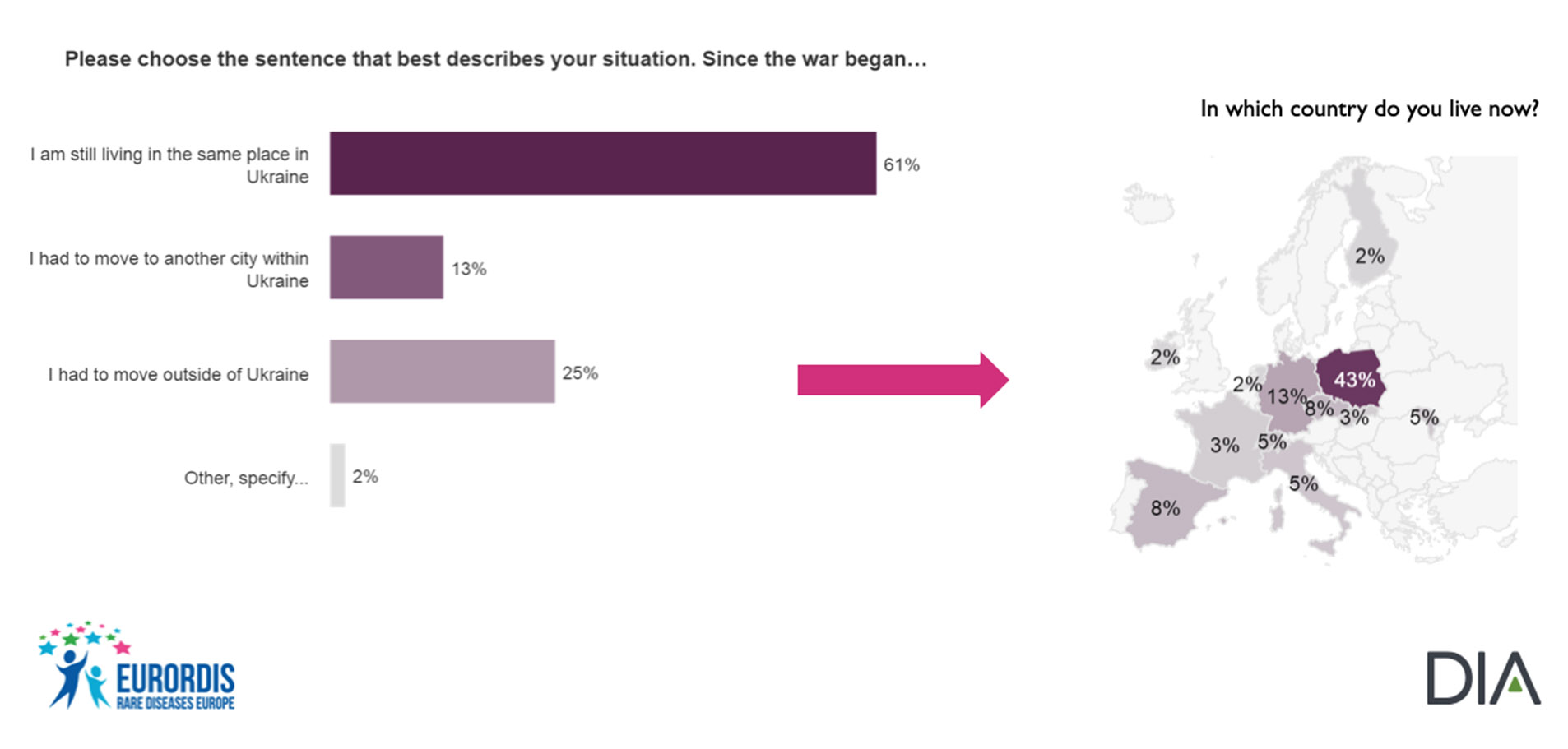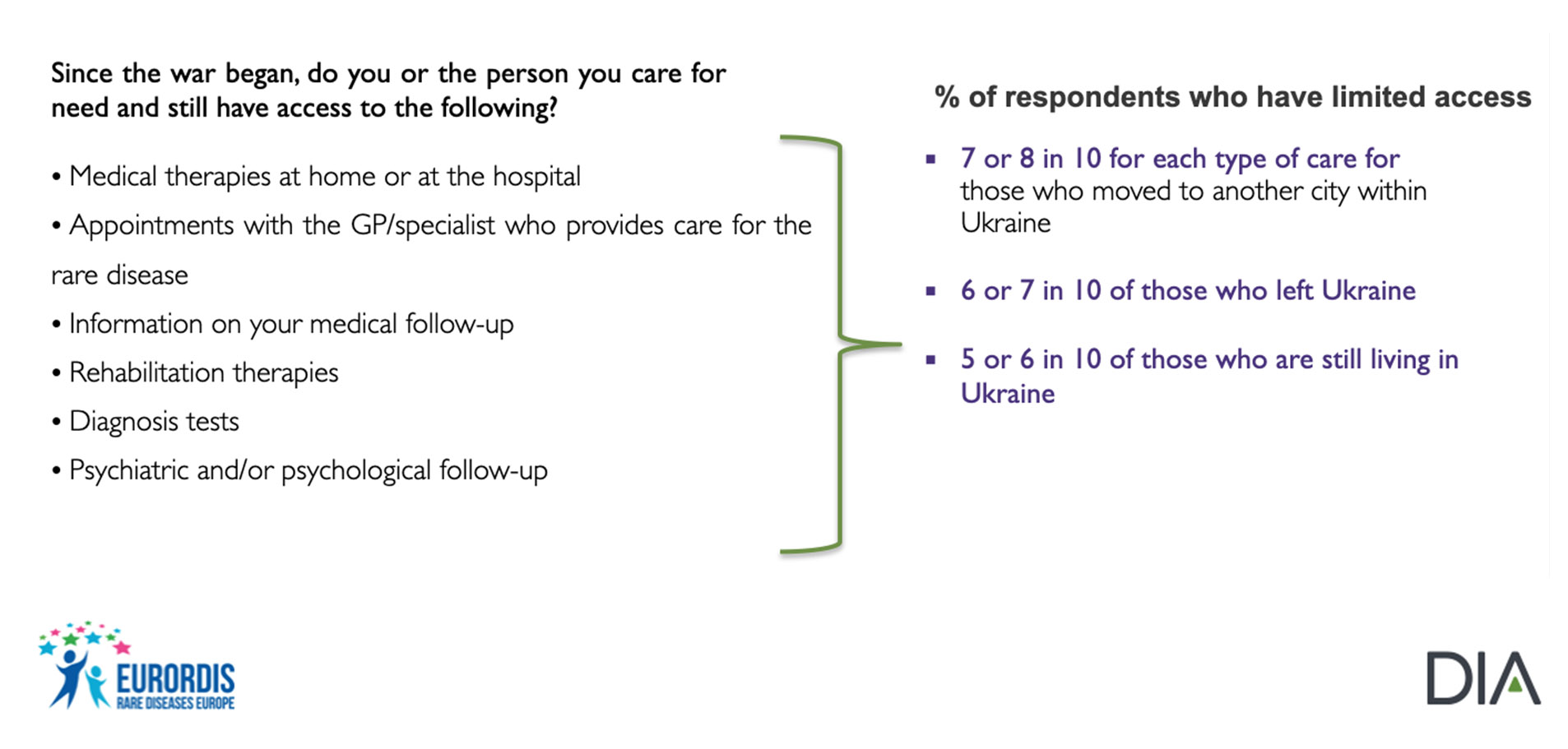t the start of the war in 2022, as many as two million people in Ukraine were living with a rare disease. The disruption of care and access to medicines caused by the conflict was a major challenge.
As early as March 2022, EURORDIS launched a project to address urgent gaps in the procurement of orphan medicines and other needs expressed by people living with a rare disease, including the conduct of a survey to understand their reality.
Movement of People Living with Rare Diseases During War
A rare barometer survey of patients living with a rare disease in Ukraine received more than 400 responses from April to June 2022. It indicated that some 60% of Ukrainians living with a rare disease stayed in the same place in Ukraine, 13% moved within Ukraine, and approximately 25% moved out of Ukraine.
Like others, people with rare diseases moved because of security concerns. They also moved because they were unable to complete treatments that would have been possible during peacetime. Almost 80% of Ukrainian rare disease patients reported having been affected by at least one interruption of their usual care: clinician appointments, medical therapies, medical follow-up, rehabilitation therapies, diagnostic tests, and mental health. Similar limitations on access were reported by approximately 65% of those who left Ukraine and between 50% to 60% of those who remained in Ukraine.
Needs Assessment for Rare Disease Patients and Their Families from Ukraine

Challenges in Access to Care and Medicine
Although patients moved due to disruptions in care and access, moving did not guarantee either care or access. Additionally, it led to other challenges and sometimes demonstrated benefits depending on where people moved to and how prepared they were to enable resumption of care in a new location.
Those who moved to other European countries faced greater challenges than those who stayed. There is often difficulty in obtaining renewals or changes of medication, as it largely depends on the location. For those fleeing the country, frequent relocation from one EU country to another was a reality, which only reinforced the challenge of obtaining medication with each move. Although this access challenge existed before the war, the numbers of people impacted multiplied by two or three times after February 2022.
The level of preparedness among families living with rare diseases that sought refuge abroad varied across the country. Some had their documents and emergency backpacks in place and were able to evacuate in a rather organized manner. They were able to reconnect to the healthcare system in another region or another country rather easily because they had their entire medical record with them. For others, it was much more challenging to obtain care and continuity of treatment after relocating.
Some people living with rare diseases who relocated outside Ukraine gained access to medications that they had not been able to receive in their home country.
Those who stayed in Ukraine as the war continued are the smallest number, although they are still severely affected. Some people had stockpiled supplies of their daily medicines and were able to take their medicines with them, even if they were moving within the country. Some people lost access to medicine because their region or city was unstable/unsafe and they needed to move to another region. For these people and their families, the major challenge is to reconnect to the healthcare system and resume receiving treatment.
Although the majority of respondents chose to remain in the country, this survey also provided evidence that 20% of those who chose to stay considered leaving in the future. This group requires ongoing attention. Obstacles preventing this population from leaving Ukraine include lack of information, financial difficulties, and uncertainty about finding proper medical transportation or healthcare facilities to treat their disease abroad.
The most vulnerable rare disease patients are those who remain on the move, either internally or abroad, because they are disconnected from their usual healthcare facilities and treatment providers.
Geographical Situation of Respondents

Barriers to Fulfilling Basic Needs
While clinical needs related to treatment or medication are the number one need, other basic needs are almost equally important. This includes:
- Financial resources
- A suitable place to live
- Enough food and hygiene products
- Close access to water, toilets, and personal health and care products.
People living with rare diseases may require accommodation beyond a typical standard. For example, some need improved accessibility or increased levels of hygiene safety.
Meeting Needs of People Where They Are
The movement of people living with rare diseases within or outside Ukraine raised new challenges. Addressing the needs of this population during wartime shows how we can design responses to meet the needs of this and other patient populations in the face of future disruptions.
These support organizations provided food and other basic supplies such as hygiene products and clothing, treatment or medicines, assistance in locating treatments or social benefits, and online information or face-to-face medical consultation.
Seventy percent of survey respondents said that they would be willing to take part in online consultations with a medical team specialized in their disease. Sometimes online consultations or telemedicine is the only way to reach patients or clinicians organizing clinical trials, and COVID-19 helped familiarize both patients and clinicians with these online digital communication tools.
8 in 10 Ukrainian Rare Disease Patients Affected by at least One Interruption of Care They Usually Receive

Responding to Short- and Long-Term Needs
The war highlighted that people living with rare diseases have immediate needs for access to basic supplies, medical care, and treatments. However, depending on their situation, they also have longer-term needs that must be met as the conflict continues. How can we think short-term and long-term at the same time?
To meet short-term needs, financial support must be provided to countries hosting Ukrainians living with a rare disease, so that providing access to healthcare services in these host countries doesn’t disproportionally affect the hosting community. Emergency response programs from pharmaceutical companies should provide access to essential medicines. Health authorities have provided important guidance for the relocation of research participants.
To meet long-term needs, mechanisms must be put in place to support patient organizations on the ground and assure sustainability in the context of dwindling donations from industry and other humanitarian partners. Pharmaceutical companies should continue to register new medicines to reduce loss of access at the conclusion of the war. Additionally, long-term cooperation with the Ministry of Health and relevant international organizations will ensure continuity of treatment and market availability of treatments for Ukrainians postwar.
Building on the Lessons of War
Ukraine taught us that even in wartime, people living with rare and other diseases can (and should) continue to have access to care and treatment. The following approaches should be considered as best practices, to ensure continuity of care:
- Coordinated response of humanitarian, patient, and government organizations and the use of networks to strengthen this response
- Provision and coordination of access and portability of health records
- Mechanisms connecting patients, medical care providers, and suppliers
- Strengthened telemedicine
- Improved access to treatments so that people can obtain the best available medicine wherever they are.
EURORDIS report on the challenges faced by displaced Ukrainians affected by a rare disease – Poland
EURORDIS report on the challenges faced by displaced Ukrainians affected by a rare disease – Moldova
EURORDIS report on the challenges faced by displaced Ukrainians affected by a rare disease – Romania
EURORDIS report: Helping Ukraine to Build Back Better for Rare Diseases

